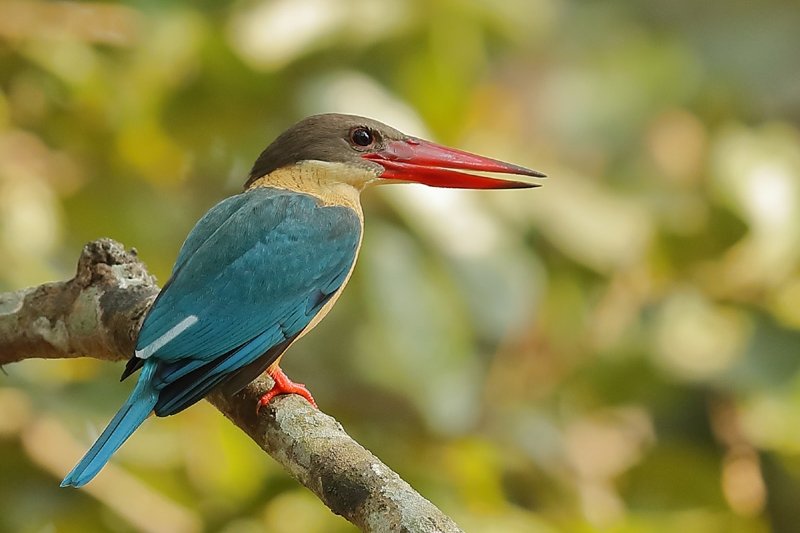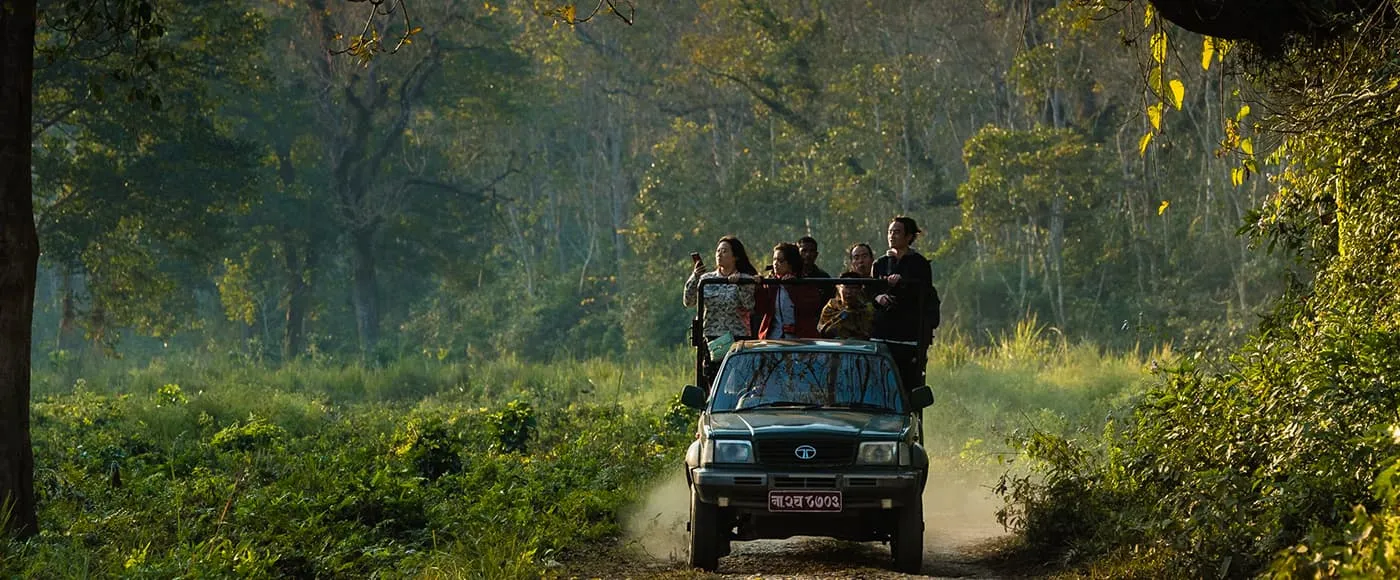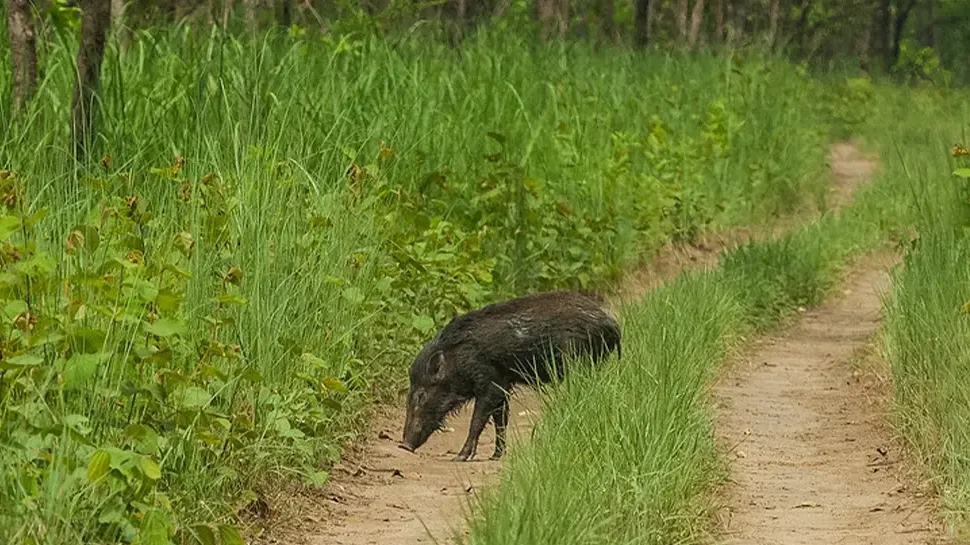Chitwan National Park is known to be a Wildlife Hub of Nepal.
A Chitwan Safari introduces one to the very wild heart of Nepal where rhinoceroses, tigers, and exotic birds can be found in their natural habitat. It lies in the lively Terai lowlands, which is thus one of the most varied habitats in Asia. This ideal hideout for both predators and prey has a thick sal forest that flows with rivers and vast grasslands.
Chitwan is a paradise for the nature lover, having more than 700 species of animals. Effective time has been given to preserve and breed different rare species like the Indian one-horned rhinoceros or the Bengal tiger. It is one of the preferred destinations in Nepal for wildlife fanatics seeking information on the protected parks of Nepal, thanks to major conservation success.
More information should be sought from the Department of National Parks and Wildlife Conservation.
CHITWAN SAFARI ANIMALS VERY EASY TO SEE

A Chitwan Safari offers close-up views of the most wonderful wildlife in Nepal. So, the great bio-diversity of the park assures that every visitor to the park is bound to have successful an exciting or memorable experience since he will observe day of all sorts from big mammals to scare reptiles in each safari ride.
Main Wildlife Highlights:
- One-Horned Rhinoceros:
The most iconic star of Chitwan Safari, standing by swamps or wallowing in the mud pools, is the one-horned rhinoceros. More often than not, active during the early mornings and late afternoons, this is highly advisable if you want to get a sight of one before the end of your Chitwan rhino safari. - Bengal Tiger:
One of the rare treats for safari-goers is the chance to see the Bengal tiger. Mostly found in deep woods, tigers require a lot of patience to see them, perhaps a helping hand from a very experience naturalist.
This is not many and cannot boast of being a place for the excitement of seeing tigers in any habitat when on safari. - Asian Elephants:
Elephants are often seen moving through the forest or standing by a waterhole. In Chitwan Safari, some of the lodges offer elephant-back safaris; this is very interesting way to view wildlife within the park. - Sloth Bears and Leopards:
Highly elusive, sloth bears are very interesting creatures. They are mainly termite feeders and have the ability to obtain honey. Leopards are shadowy predators of the park; hardly seen, but it does add excitement for photographers and wildlife enthusiasts. - Gharials and Marsh Crocodiles:
Sunbathing on the banks of the Rapti and Narayani rivers are the gharials and marsh crocodiles—the most fascinating reptile to watch. This now gives wildlife photographers a good chance to take pictures of some rare species of the riverine fauna in Nepal. - Deer, Wild Boars, and Monkeys:
Sambars and barking deer and wild boars can be seen, generally, on a jeep or walking safari. It is the life and movement added by troops of rhesus monkeys and langurs that enhance forests, particularly near the edge of a forest and river. - Rare Species:
Guests can also expect to see some pangolins, monitor lizards, and other small mammals on each safari in Chitwan, making it a type of potential treasure hunt for wildlife enthusiasts.
Safari Experience Tips:
- Use binoculars when viewing animals difficult to spot.
- This happens during the best times: early in the morning and late in the afternoon
- Always head your guide’s instruction for safety and proper viewing
Bird Watching in Chitwan

Bird watchers will never forget the experience of watching birds in Chitwan Safari. The park is home to more than 500 bird species that are resident and migratory in nature. The park also provides some of the finest bird-watching habitats in the country because of its so diverse habitats of rivers, wetlands, grasslands, and forests. .
Top Birdwatching Highlights:
- Kingfishers, Hornbills, and Storks:
These splashy birds are found along the Rapti and Narayani rivers, offering a subject photographers will delight in. Of particular interest to many visitors is the Great Hornbill. - Bengal Florican:
It is an open, critically endangered grassland bird and can be often sighted during the winter months—rare, for interested parties. Migratory Birds: - Migratory Birds:
They join the park’s resident species between November and February, increasing birdlife diversity. - Waterfowl and Wetland Birds:
In lakes, ponds, and rivers, the sightings of species such as egrets, cormorants, and herons are good. For this reason, most birds are approachable for both observation and photography.
Tips for Birdwatchers:
- Early morning walking provides the best chance to see active birds.
- Binoculars and field guide will make identification really easy.
- Move quietly to avoid disturbing the birds.
A combination of grasslands, wetlands, and dense forests equal to those found in Chitwan cannot be located in other parts of Nepal, so it turns out to be a delight for anyone—be it a casual visitor or a serious birdwatcher.
Tips for the Best Chitwan Safari Experience
Best Time to Visit
The best times are from October through March, these particular months offer a very good atmosphere and maximum wildlife activity. Short grass increases the spotting ability of rhinoceros, tiger and other wildlife.
Safari Options
- Jeep Safari: Covers large areas with maximum sighting possibilities for large animals.
- Canoe Ride: Softly cruise down the Rapti River—a perfect spot to view crocs and water birds.
- Walking Safari: Guided walk to forests.
Safety Tips
- Stay as far as you can from the rhinoceroses, elephants, and predators.
- Stay quiet near animals; don’t make noise as this may disturb them.
- Please try to wear dark-colored clothing; avoid wearing bright colors.
- Walk with a certified guide or naturalist.
Final Thoughts
A safari to Chitwan is not merely a thrill but an expedition into the wild heart of Nepal. It is a journey from where the great rhinos graze beside the rivers down to the elusive Bengal tigers in the forests, up to the hovering exotic kinds of birds, and down to the roaming majestic elephants. It all ends up being experiences that stick with you forever.
A Chitwan safari is a very memorable experience that every wildlife photographer, nature lover, or first-time visitor will forever keep close to his heart.Experience the wildlife of Nepal with a safari in Chitwan!
Plan your Chitwan Safari today and witness the wildlife of Nepal like never before!
Click Here to Book – Chitwan Jungle Safari
FAQs About Chitwan Safari
1. What animals can I see on a Chitwan Safari?
You can spot the one-horned rhinoceros, Bengal tiger, sloth bear, elephant, and over 500 bird species, making wildlife in Chitwan National Park among the richest in Asia.
2. When is the best time for bird watching in Chitwan?
The best time is between November and February, when migratory birds join resident species, offering spectacular sightings.
3. What types of safaris are available in Chitwan?
Visitors can choose jeep safaris, canoe rides, or guided walking safaris depending on their interests and fitness level.
4. How can I maximize wildlife sightings during a Chitwan Safari?
Early morning and late afternoon are the most active times. Using binoculars, following a certified guide, and maintaining quiet are essential for spotting elusive animals




